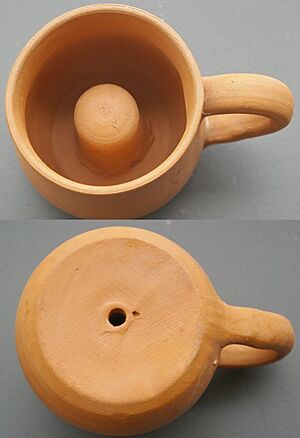Pythagorean cup facts for kids
A Pythagorean cup is a clever drinking cup. It's also known as a Pythagoras cup or Greedy Cup. People say the ancient Greek thinker Pythagoras invented it. This cup looks normal, but it has a secret. If you fill it too much, all the liquid drains out! It's a fun practical joke device. It can also teach us about being too greedy.
How the Mysterious Cup Works
A Pythagorean cup seems like a regular cup. But inside, it has a special central column. This column sits right over the cup's stem. There's a small hole at the very bottom of the stem.
Inside the central column, there's a hidden pipe. This pipe goes from the bottom hole almost to the top of the column. At the top, there's a small open space, like a tiny room. Another pipe connects this room to a hole lower down in the central column. This lower hole lets liquid from the cup's bowl enter the pipe.
When you pour liquid into the cup, it fills the bowl. The liquid also rises up the second pipe. This happens because of Pascal's principle. It means liquids in connected spaces try to stay at the same level.
If you don't fill the cup too high, it works like any other cup. You can drink from it normally. But if the liquid level goes above the small room at the top of the central column, something cool happens. The liquid spills into the first pipe. Then, it flows out through the hole at the bottom of the stem.
This starts a siphon effect. A siphon is like a secret pathway for liquid. Once it starts, gravity pulls all the liquid out of the cup. The entire contents empty through the hole at the bottom. It's a clever trick! Many modern toilets use a similar siphon idea to empty their bowls.

How the Cup's Idea is Used Today
The smart design of the Pythagorean cup is still used today. For example, some washing machines use a similar idea. This happens in the fabric softener tray of a top-load washing machine. It helps spread the softener evenly.
Pythagoras introduced the siphon idea over 2,500 years ago. It's amazing that his mechanical concept is still useful! In these washing machines, the softener tray acts like a Pythagorean siphon. It has different sections where liquids can flow.
When you pour fabric softener into the tray, you must stay below a certain line. If you pour too much, the softener would drain out right away. This is because the siphon effect would start.
When the washing machine needs to add the softener, it pours water into the tray. This water makes the liquid level go above the "fill line." This starts the siphon process. The mixture of water and softener begins to pour out.
The way the liquid flows creates a seal. This seal stops air from getting into the central part of the siphon. Because air can't get in, the weight of the liquid mixture pushes it all out. This sends the fabric softener directly into the washing machine tub. It's a neat way to make sure your clothes get soft!
See also
In Spanish: Copa de Pitágoras para niños


